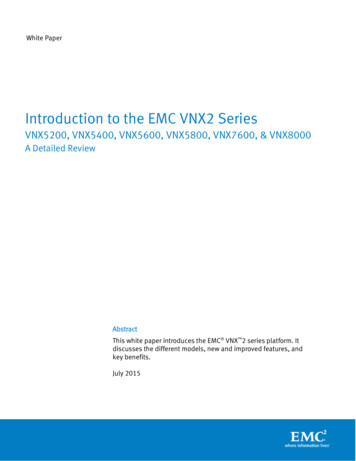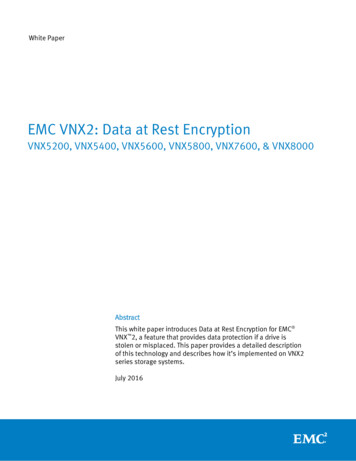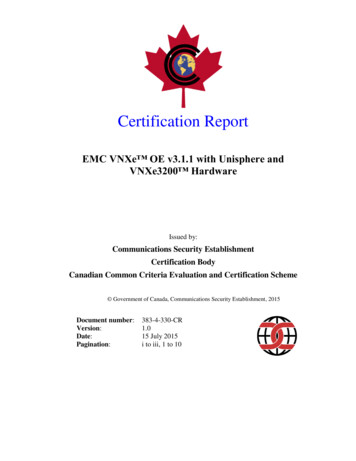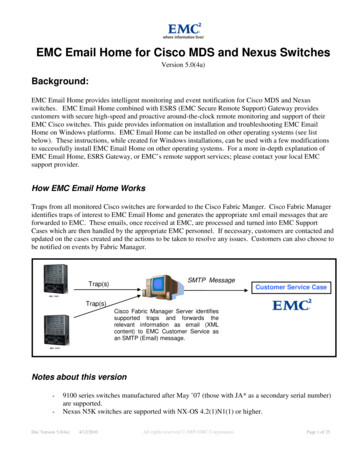
Transcription
White PaperIntroduction to the EMC VNX2 SeriesVNX5200, VNX5400, VNX5600, VNX5800, VNX7600, & VNX8000A Detailed ReviewAbstractThis white paper introduces the EMC VNX 2 series platform. Itdiscusses the different models, new and improved features, andkey benefits.July 2015
Copyright 2015 EMC Corporation. All rights reserved.EMC believes the information in this publication is accurate of itspublication date. The information is subject to change withoutnotice.The information in this publication is provided “as is.” EMCCorporation makes no representations or warranties of any kindwith respect to the information in this publication, andspecifically disclaims implied warranties of merchantability orfitness for a particular purpose.Use, copying, and distribution of any EMC software described inthis publication requires an applicable software license.For the most up-to-date listing of EMC product names, see theEMC corporation trademarks page at EMC.com.VMware is a registered trademark of VMware, Inc. All othertrademarks used herein are the property of their respectiveowners.Part Number: H12145.6Introduction to the EMC VNX2 Series – A Detailed ReviewVNX5200, VNX5400, VNX5600, VNX5800, VNX7600, & VNX80002
Table of ContentsExecutive summary . 5Audience . 5Terminology . 6VNX family overview . 8VNX hardware components . 9Configurations . 10Components and features in the VNX2 . 14Xeon E5 processor . 14Li-Ion SPS, BBUs, and power . 14High-capacity and small form factor drives . 15New Control Station . 15DAEs, DPEs, and drives provide increased density . 156 Gb/s x 4 lane and 6 Gb/s x 8 lane SAS back-end. 31Expanded UltraFlex I/O using PCI-E Gen 3 increases bandwidth . 31VNX2 models . 32VNX5200 . 34VNX5400 . 38VNX5600 . 39VNX5800 . 40VNX7600 . 41VNX8000 . 42VNX Gateway . 48I/O modules . 49I/O modules for the Storage Processor . 49I/O modules for the Data Mover . 55Control Station . 60Software on the VNX2 series . 61MCx . 61Reserved area on VNX2 series storage systems. 63Unified management . 63Software for efficiency . 65Fully Automated Storage Tiering for Virtual Pools (FAST VP) . 65Multicore FAST Cache. 66Deduplication and compression . 67Windows 8.1 and Server 2012 R2 . 70Virtual Data Movers (VDMs) . 72Thin Provisioning . 73Introduction to the EMC VNX2 Series – A Detailed ReviewVNX5200, VNX5400, VNX5600, VNX5800, VNX7600, & VNX80003
Software for protection . 74VNX Replicator . 74RecoverPoint integration . 75MirrorView/A . 75MirrorView/S . 75SAN Copy . 76Business continuance. 77SnapView snapshots . 77SnapSure checkpoints . 78SnapView clones . 78Security . 79Data-At-Rest Encryption . 79Anti-virus software . 80Quota management and auditing. 80File-Level Retention. 80Advanced Data Services support for file . 82Serviceability, availability, and performance . 83Unisphere one-button shutdown. 83Unified software upgrade . 84Unified remote support . 84VNX2 scalability and performance . 86Conclusion . 87Appendix A: System, block, and file level components . 88Appendix B: Storage processor UltraFlex I/O slot availability . 92Appendix C: Drive Support . 94Introduction to the EMC VNX2 Series – A Detailed ReviewVNX5200, VNX5400, VNX5600, VNX5800, VNX7600, & VNX80004
Executive summaryPower, efficiency, protection, and simplicity are four traits that must characterize an arrayin today’s high demand storage environment. Storage systems are required to providepowerful and efficient storage technologies, keep data protected, and be simple to useand manage.The VNX multicore initiative, MCx , is an architecture project that redesigns the coreBlock OE stack within the new VNX series (VNX2). Developed with many goals, the MCxplatform’s most significant mission is CPU Scaling. This mission is very simple: takeadvantage of the many CPU cores that the Intel microarchitecture offers and create asolution for further technological growth.The VNX2 platform is a union of increased hardware performance and the extensive codechanges required to support it. The optimization focuses on ensuring that cachemanagement and back-end RAID management processes take full advantage of multicoreCPUs, allowing cache and back-end processing software to scale in a linear fashion. Inthis way, EMC fully leverages the power of Intel’s latest multicore CPUs. The VNX2 serieshas a scaling factor of 97 percent, so future scaling using additional cores is guaranteed.This not only allows EMC to deliver cost efficient performance, but also to scale whiledelivering advanced efficiency and protection.The VNX2 series is designed for a wide range of environments from mid-tier to enterprise.Each VNX2 model is offered in file only, block only, and unified (block and file)implementations. The VNX2 series is still managed through a simple and intuitive userinterface called Unisphere ; this single pane of glass completes the unified experience.This white paper discusses the VNX2 series models (VNX5200 , VNX5400 ,VNX5600 , VNX5800 , VNX7600 , and VNX8000 ), their hardware and software,limits, I/O modules, and more. This paper also describes the software, serviceability, andavailability features of the VNX2 platform, such as MCx, Block Deduplication, FAST ,Data-At-Rest Encryption, Windows 8.1/Server 2012 R2 support, One Button Shutdown,and Unisphere Service Manager.For details on the VNX5100/VNX5300/VNX5500/VNX5700/VNX7500 models, refer to thewhite paper titled Introduction to the EMC VNX Series – VNX5100, VNX5300, VNX5500,VNX5700, & VNX7500: A Detailed Review, available on EMC Online Support.AudienceThis white paper is intended for IT architects, administrators, and others who areinterested in the VNX2 series arrays. It assumes familiarity with storage array concepts,general hardware, and the software services provided by the arrays.Introduction to the EMC VNX2 Series – A Detailed ReviewVNX5200, VNX5400, VNX5600, VNX5800, VNX7600, & VNX80005
TerminologyAutomatic Volume Management (AVM)—Feature of VNX File Operating Environment (OE)that creates and manages volumes automatically without manual volume managementby an administrator. AVM organizes volumes into storage pools that can be allocated tofile systems.Converged Network Adapter (CNA)—Host adapter that allows a host to process FibreChannel and Ethernet traffic through a single type of card and connection, decreasinginfrastructure costs over time.Disk Array Enclosure (DAE)—Shelf in a VNX2 that includes: an enclosure; either 15, 25,60, or 120 disk modules; two SAS link control cards (LCCs) or InterConnect Modules(ICMs); and two power supplies. It does not contain storage processors (SPs).Disk Processor Enclosure (DPE)—Shelf in the VNX2 that includes: an enclosure; diskmodules; storage processors (SPs); two base modules; two battery backup units (BBUs);two power supplies; up to ten I/O modules; and four fan packs. A DPE supports DAEs inaddition to its own disk modules. This 3U form factor is used in the VNX5200 ,VNX5400 , VNX5600 , VNX5800 , and VNX7600 . It supports a maximum of 125, 250,500, 750, and 1,000 drives, respectively.Base Module—Part of the VNX2 DPE, a single base module contains two Serial-attachedSCSI (SAS) back-end ports, one power supply, and one battery backup unit (BBU).Fibre Channel (FC)—Gigabit-speed data transfer interface technology. Data can betransmitted and received simultaneously. Common transport protocols, such as InternetProtocol (IP) and Small Computer Systems Interface (SCSI), run over Fibre Channel.Consequently, a single connectivity technology can support high-speed I/O andnetworking.Fibre Channel over Ethernet (FCoE)—Allows Fibre Channel frames to be encapsulated viaEthernet. With Converged Network Adapter cards, a host may use one type of adapter andcable for Ethernet and Fibre Channel traffic.Flash drive—Flash drives provide extremely high performance and consume very littlepower. These drives enable a VNX2 to provide an Extreme Performance level of storagefor critical workloads. Flash drives can also extend the array’s cache using FAST Cachetechnology. The VNX2 series supports both FAST Cache Optimized drives and FAST VPoptimized drives.Fully Automated Storage Tiering for Virtual Pools (FAST VP)—Advanced data service thatrelocates data of pool-based LUNs at a sub-LUN level to optimal locations within astorage pool.Logical Unit Number (LUN)—Identifying number of a SCSI or iSCSI object that processesSCSI commands. The LUN is the last part of the SCSI address for a SCSI object. The LUN isan ID for the logical unit, but the term often refers to the logical unit itself.MCx—Multicore initiative (Multicore Cache, Multicore FAST Cache, Multicore RAID) andre-architecture project that redesigns the Block OE stack within the VNX2 series. MCxIntroduction to the EMC VNX2 Series – A Detailed ReviewVNX5200, VNX5400, VNX5600, VNX5800, VNX7600, & VNX80006
delivers core functionality improvements making the VNX Block OE more robust, reliable,predictable, and easier to use than ever before.Multicore Cache—VNX array cache (sometimes referred to as DRAM Cache) is an MCxsoftware component that increases host write and read performance by using the VNX2Storage Processor’s DRAM.Multicore FAST Cache—Large capacity secondary cache that uses enterprise Flash drives.Multicore RAID—MCx component that defines, manages, creates, and maintains VNX2RAID protection.Near-Line Serial Attached SCSI (NL-SAS) drives—Enterprise SATA drives with a SASinterface head, media, and rotational speed of Enterprise SATA drives with a fully capableSAS interface. These drives provide similar performance and capacity to SATA drives,utilizing a SAS interface for I/O.Serial-attached SCSI (SAS)—Communication protocol used to move data to and fromcomputer storage devices. SAS is a point-to-point serial protocol that replaces parallelSCSI bus technology. Expanders facilitate the connection of multiple SAS end devices toa single initiator port.I/O Module—A hardware component that provides front-end and back-end connectivitybetween the storage processors disk-array enclosures, and hosts.Storage Processor Enclosure (SPE)—Shelf in the VNX2 that includes: an enclosure;storage processors (SPs); up to twenty-two I/O modules; four power supplies; and tenfan assemblies. This 4U form factor is used for the high-end VNX8000 and supports amaximum of 1,500 drives.Storage Pool—Single repository of homogeneous or heterogeneous physical disks fromwhich LUNs may be created. This concept enables ease of use and technologies such asFAST VP.Introduction to the EMC VNX2 Series – A Detailed ReviewVNX5200, VNX5400, VNX5600, VNX5800, VNX7600, & VNX80007
VNX family overviewThe VNX family includes the VNXe , VNX, andVNX2 series arrays. The VNXe series isdesigned for small-to-midsize storage environments, while the VNX series is designed formidtier-to-enterprise storage environments.The VNX2 series is EMC’s next generation of midrange-to-enterprise products. The VNX2series utilizes EMC’s VNX Operating Environment for Block & File that you can managewith Unisphere, a simple, easy to use management framework. This VNX2 softwareenvironment offers significant advancements in efficiency, simplicity, and performance.The VNX2 series includes six models that are available in block, file, and unifiedconfigurations: VNX5200 VNX5400 VNX5600 VNX5800 VNX7600 VNX8000There are two existing Gateway models: VNX VG2 VNX VG8There are two VMAX Gateway models: VNX VG10 VNX VG50The VNX2 series offers: State-of-the-art hardware: PCI-E Gen 3 I/O modules 6 Gb/s x 4 lanes SAS back-end infrastructure Up to x 8 wide (6 Gb/s x 8 lanes) high-bandwidth connection to 60 drive DAEwith new 6 Gb SAS I/O module Increased memory and core optimization with MCx Intel’s latest Xeon E5 multicore processors Expanded UltraFlex I/O, delivered with denser packaging NEBS (Network Equipment-Building System) certified DC-powered arrays(VNX5200, VNX5400, & VNX5600)Introduction to the EMC VNX2 Series – A Detailed ReviewVNX5200, VNX5400, VNX5600, VNX5800, VNX7600, & VNX80008
Block functionality that supports the FC, iSCSI, and FCoE protocols File functionality that supports the NFS, CIFS, and pNFS protocols Support for up to 1,500 drives Ultra-dense 120-drive DAE Automated tiering with Fully Automated Storage Tiering for Virtual Pools (FAST VP) forblock and file data Controller based, drive level, Data-At-Rest Encryption Updated unified management with Unisphere delivers a cohesive, unified userexperienceVNX hardware componentsVNX2 storage systems include these hardware components: Storage Processors (SPs) support block data with UltraFlex I/O technology thatsupports Fibre Channel, iSCSI, and FCoE protocols. The SPs provide access for allexternal hosts and the file components of the VNX array. The Storage Processor Enclosure (SPE) is 4U in size and houses dual storageprocessors. This form factor is used for the high-end VNX8000 model. It does notcontain any onboard drive slots and requires the use of DAEs, supporting a maximumof 1,500 drives. The Disk Processor Enclosure (DPE) is 3U in size and houses dual storage processorsand the first tray of disks. Mid-to-high-end VNX2 models (VNX5200, VNX5400,VNX5600, VNX5800, and VNX7600) use this form factor. It contains 25 x 2.5”onboard drive slots and supports a maximum of 125, 250, 500, 750, and 1000drives, respectively. Blade (or Data Mover) accesses data from the back end and provides host accessusing the same UltraFlex I/O technology that supports the NFS, CIFS, and pNFSprotocols. The blades in each array are scalable and provide redundancy. The Data Mover Enclosure (DME) is 2U in size and houses the Data Movers (Blades).All file and unified VNX models use at least one DME. Li-Ion Standby Power Supplies (SPSs) are 2U in size and used only in the VNX8000.There are two SPSs in a VNX8000 array. Each SPS has two batteries. One SPSprovides backup power to the SPE, and the second to the first DAE. These SPSsprovide enough power to each storage processor and first DAE to ensure that any datain flight is de-staged to the vault area in the event of a power failure, guaranteeing nowrites are lost. When the array is restarted, the pending writes are reconciled andpersisted. Battery Backup Units (BBUs) are used in the VNX5200, VNX5400, VNX5600,VNX5800, and VNX7600. There are a total of two BBUs per array (one per SP) and theyIntroduction to the EMC VNX2 Series – A Detailed ReviewVNX5200, VNX5400, VNX5600, VNX5800, VNX7600, & VNX80009
are installed in the base module of each SP. BBUs provide enough power to ensurethat any data in flight is de-staged to the vault area in the event of a power failure. Control Stations are 1U in size and provide management functions to the file blades.The Control Station is responsible for controlling blade failover. The Control Stationmay optionally be configured with a matching secondary Control Station to ensureredundancy on the VNX2 array. Disk Array Enclosures (DAE) house the drives used in the array. They enable theexpansion of each array’s drive count to provide the storage needed for expandingneeds over time of each implementation. The 15-drive DAE is 3U in size, the 25-driveis 2U in size, the 60-drive DAE is 4U in size, and the 120-drive DAE is 3U in size. The SPE/DPE and DME use dual power supplies that are integrated into the chassis,and provide back-up electricity if a single power supply fails. For NAS services (i.e., Data Mover Blade I/O options): 4-port 1 GbaseT Ethernet copper module 2-port 10 Gb Ethernet optical/twin-ax module 2-port 10 GBaseT Ethernet copper moduleFor Block Services to host (i.e., Storage Processor I/O options): 4-port 8 Gb optical Fibre Channel UltraFlex I/O module 4-port 1 GBaseT Ethernet iSCSI/TOE module 2-port 10 Gb Ethernet optical/twin-ax iSCSI/TOE module 2-port 10 GBaseT Ethernet copper iSCSI/TOE module 2-port FCoE optical/twin-ax moduleConfigurationsThe hardware components of a VNX2 depend on the overall configuration and optionsordered. The three basic configurations are: Block—Supports block data File—Supports file data Unified—Supports block and file dataBlock configuration – supports block data (shown in Figure 1)This configuration supports the FC, iSCSI, and FCoE protocols and consists of: 3U DPE (disk-processor enclosure) for VNX5200, VNX5400, VNX5600, VNX5800, andVNX7600, or 4U SPE (storage-processor enclosure) for VNX8000 at least one DAE forVault Drives. [optional] 2U 25-drive DAE, or 3U 15-drive DAE, or 4U 60-drive DAE (in deep rack), or3U 120-drive DAE (in deep rack) up to the system maximumIntroduction to the EMC VNX2 Series – A Detailed ReviewVNX5200, VNX5400, VNX5600, VNX5800, VNX7600, & VNX800010
Dual 2U Li-Ion SPSs for VNX8000Figure 1: Block configurations for VNX5600 (left) and VNX8000 (right)File configuration – supports file data (shown in Figure 2)This configuration supports the NFS, CIFS, and pNFS protocols and consists of: 3U DPE (disk-processor enclosure) for VNX5200, VNX5400, VNX5600, VNX5800, andVNX7600 or 4U SPE (storage-processor enclosure) for VNX8000 at least one DAE forVault Drives [optional] 2U 25-drive DAE (disk-array enclosure), or 3U 15-drive DAE, or 4U 60-driveDAE (in deep rack), or 3U 120-drive DAE (in deep rack) up to the system maximum At least one 2U Blade (or Data Mover) enclosure One or two 1U Control Stations Dual 2U Li-Ion SPSs for VNX8000Introduction to the EMC VNX2 Series – A Detailed ReviewVNX5200, VNX5400, VNX5600, VNX5800, VNX7600, & VNX800011
Figure 2. File configurations for VNX5600 (left) and VNX8000 (right)Unified configuration – supports file and block data (shown in Figure 3)The unified configuration supports the FC, iSCSI, and FCoE protocols for block data andthe NFS, CIFS, and pNFS protocols for file data. A unified configuration has the samecomponents as a file configuration.Introduction to the EMC VNX2 Series – A Detailed ReviewVNX5200, VNX5400, VNX5600, VNX5800, VNX7600, & VNX800012
Figure 3. Unified configurations for VNX5600 (left) and VNX8000 (right)Introduction to the EMC VNX2 Series – A Detailed ReviewVNX5200, VNX5400, VNX5600, VNX5800, VNX7600, & VNX800013
Components and features in the VNX2The VNX2 series arrays are comprised of advanced components that have these features: Intel Xeon E5 processor makes the VNX2 faster and greener Dual Li-Ion SPSs with removable battery backs and upgradeable firmware onVNX8000 Dual BBUs located inside of the DPE of VNX7600, VNX5800, VNX5600, VNX5400, andVNX5200o BBUs replace traditional SPSs and support firmware upgrades New Control Station with faster CPU and increased memory High- capacity and small form factor driveso New FAST VP optimized drives Increased density from new DAEs, DPEs, and drives 6 Gb/s x 4 lanes SAS back-end improves performance and availabilityo x 8 SAS back-end connection introduced with back-end SAS I/O module andboth the 60-drive and 120-drive DAEs Expanded UltraFlex I/O using PCI-E Gen 3 increases bandwidthXeon E5 processorThe VNX2 series uses Intel’s Xeon E5 processor. This new 32 nm processor architectureprovides multicore capability that translates into significant scalability for all VNX2models. The processor speeds range from 1.80 GHz to 2.7 GHz and have four to eightcores per socket. As a result, these processors pack more processing power in a smallerfootprint, consume less power, and keep systems cooler.Li-Ion SPS, BBUs, and powerThe VNX8000 utilizes Li-Ion SPSs with removable battery trays, and all other modelsutilize new BBUs.Power supplies provide the information necessary for Unisphere to monitor and displaythe ambient temperature and power consumption. The power supplies: Use a lead-free construction Meet the EPA Gold Standard for efficiency targets (90 percent) Provide adaptive cooling, in which an array adjusts the power supply fan speeds tospin only as fast as needed to ensure sufficient cooling. This optimizes blower speedsand energy consumption. The power supplies have an onboard sensor that providesenergy information reporting. The reports include input power and air inlettemperature for each enclosure on the array, as well as input power reporting at anIntroduction to the EMC VNX2 Series – A Detailed ReviewVNX5200, VNX5400, VNX5600, VNX5800, VNX7600, & VNX800014
overall array level. The values are based on a rolling average for each hour that isreported in the Unisphere GUI, as shown in Figure 4.Figure 4. Energy information provided in the Unisphere Environment tabHigh-capacity and small form factor drivesThe VNX2 series supports high-capacity 4 TB drives, along with small form factor 2.5”Flash, SAS, and NL-SAS drives.New Control StationThe VNX2 series introduces a new Control Station that offers improved administrationperformance (due to a quad-core Intel Xeon Processor) and increased memory.DAEs, DPEs, and drives provide increased densityThe VNX2 series uses updated components and new drive options that make itsignificantly denser than earlier models: 25-drive DAEs and DPEs paired with 2.5” SAS drives—Increased performance andspindle density are provided by 25-drive DAEs and DPEs paired with 2.5” SAS drives,available in both 10K and 15K rpm speeds. 15-drive DAEs paired with 3.5” 4 TB 7.2K rpm NL-SAS drives—In terms of drivecapacity, maximum density is achieved by using 15-drive DAEs paired with 3.5” 4 TB7.2K rpm NL-SAS drives. This combination allows more spindles and storage capacityper square foot than in any other previous array using the 15-drive enclosures. 60-drive high-capacity DAE paired with 3.5” 7.2 K rpm NL-SAS drives and 2.5" 15 Krpm drives using a 3.5"-carrier—This dense enclosure utilizes a top load design, using4U of rack space, providing the VNX2 with 15 drives per U. In terms of drive capacity,Introduction to the EMC VNX2 Series – A Detailed ReviewVNX5200, VNX5400, VNX5600, VNX5800, VNX7600, & VNX800015
maximum density is achieved by using 3.5” 4TB 7.2K rpm NL-SAS drives. Increasedperformance may be achieved by using 2.5" and 3.5" Flash and 10-15 K rpm driveswith the use of a 3.5"-carrier. The 60-drive DAE requires a deep rack for housing. 120-drive high capacity DAE paired with 2.5” SAS and Flash drives—This ultra-denseenclosure utilizes a top load design, using only 3U of rack space, providing the VNX2with 40 drives per U. Performance and spindle density are achieved by 120-driveDAEs paired with 2.5” SAS drives, available in both 10K and 15K rpm speeds, as wellas 2.5” Flash drives. The 120-drive DAE requires a deep rack for housing.Figure 5. Block dense configuration exampleIntroduction to the EMC VNX2 Series – A Detailed ReviewVNX5200, VNX5400, VNX5600, VNX5800, VNX7600, & VNX800016
Figure 6. Unified dense configuration exampleIntroduction to the EMC VNX2 Series – A Detailed ReviewVNX5200, VNX5400, VNX5600, VNX5800, VNX7600, & VNX800017
The 25-drive 2.5” DAE and DPE supports 2.5” SAS, 2.5” NL-SAS, and 2.5” Flash drivesThe 25-drive DAE and DPE can be populated with any combination of 2.5” Flash, SAS,and NL-SAS drives. These options enable you to configure your system for optimalefficiency and performance. Unisphere identifies this DAE as “DAE5S”.Figure 7 and Figure 8 show the front and back of the 25-drive DAE that is housing 2.5”SAS drives.Figure 7. Front of the 25-drive DAE housing 2.5” drivesFigure 8. Back of the 25-drive DAE housing 2.5” drivesFigure 9 shows the back of the 25-drive DAE. In this figure, you can see theprimary/extension SAS ports; SPS ports; and the LEDs for power, fault, SAS lane status,bus number, and enclosure number.These 25-drive DAEs are compatible across the entire VNX series, as the DAEs use SAS asthe back-end bus architecture. VNX series arrays do not accept previous-generation (CXseries) DAEs.Introduction to the EMC VNX2 Series – A Detailed ReviewVNX5200, VNX5400, VNX5600, VNX5800, VNX7600, & VNX800018
Figure 9. Close-up of the back of the 25-drive DAEThe 15-drive DAE supports 2.5” SAS, 3.5” NL-SAS, and 3.5” Flash drivesThe 15-drive DAE, shown in Figure 10 and Figure 11, can be populated with 2.5” drives in3.5” carriers. The 15-drive DAE may also be populated with any combination of 3.5”Flash, SAS, and NL-SAS drives. Unisphere identifies this DAE as “DAE6S”.These opt
Introduction to the EMC VNX2 Series -A Detailed Review 8 VNX5200, VNX5400, VNX5600, VNX5800, VNX7600, & VNX8000 VNX family overview The VNX family includes the VNXe , VNX, andVNX2 series arrays. The VNXe series is designed for small-to-midsize storage environments, while the VNX series is designed for midtier-to-enterprise storage environments.










